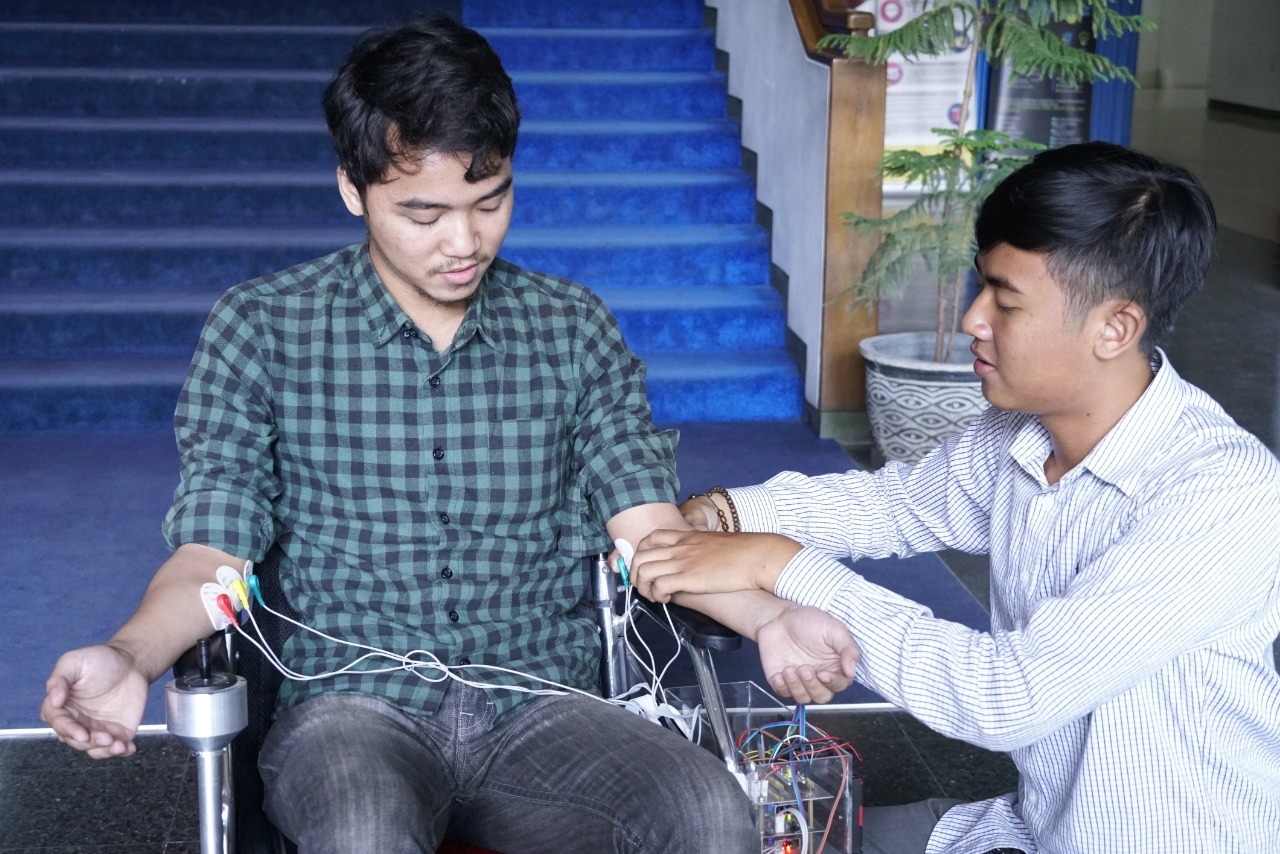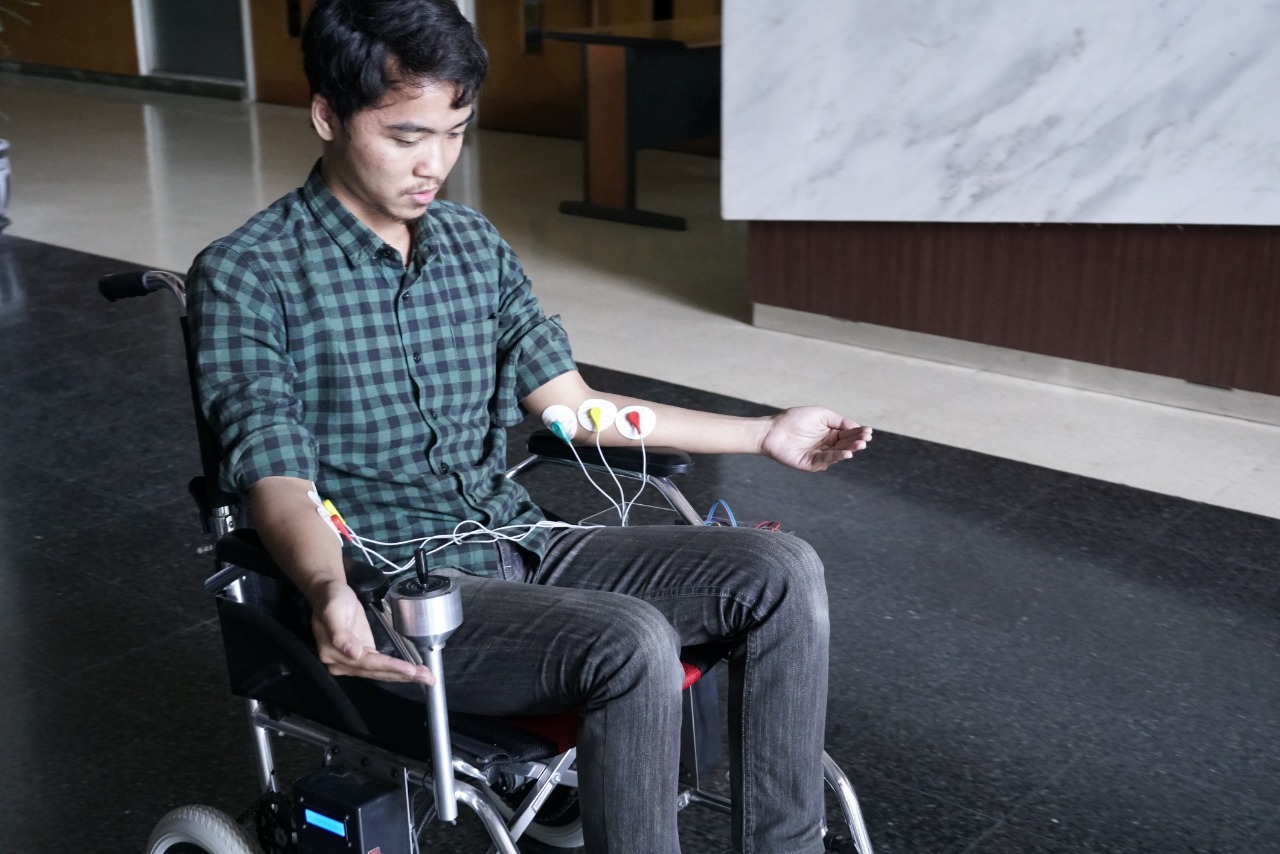ITS Student Design an Automatic Wheelchairs for Disability

I Wayan Nudra Bajantika Pradivta (right) when pairing the electrodes on the arm of the automatic wheelchair user to demonstrate the design.
ITS Campus, ITS News – to facilitate the movement of people with disabilities and stroke sufferers who are paralyzed, students of the Institut Teknologi Sepuluh Nopember (ITS) I Wayan Nudra Bajantika Pradivta designed an automatic wheelchair that could be controlled with the movement of hand muscles.
Wheelchairs made by students from Departement of Biomedical Engineering, Faculty of Electrical Technology (FTE) who will be graduated tomorrow on Saturday (14/9), is the result of his final task (TA) research titled Design Order Myoelectric Control as a seat order Electric wheels for mobility with disabilities. In his research, under the guidance of Dr. Achmad Arifin ST MEng as their lecturer who is also the head of Departement of Biomedical Engineering ITS.
Paralysis in human mobility means that people are difficult to make movements or activities. Special tools are required, one of them is a wheelchair. However, existing wheelchairs generally still require the strength of the body of the user to be able to move the seat.
The electronic wheelchairs made by students who commonly called Nudra are designed with the development of controls in hand’s muscles. With an electromyograph sensor, this innovative wheelchair will use movements ranging from the wrist as a controller of direction and motion of a wheelchair.
Nudra revealed that the electronic wheelchairs were previously created by the Department of Biomedical Engineering. However, the movement is still in a joystick and a bioimpedance sensor with a back stimulus. “When the back is too often in-stimulus the muscles will fatigue so it can be caused a big error,” he said.

Automatic wheelchair design by I Wayan Nudra Bajantika Pradivta, a biomedical engineering student when demonstrating
This electronic wheelchair needs three months of study for work by putting the electrode as a muscle control on each arm. If you turn right, the right palm is moved and as well to turn left. To move forward, it must move both palms together. “For now, it is still not able to rewind, so the user has to twist by keep turning into one direction,” explained student who born in Dili on March 5, 1997.
In his research, the student who has 3.35 GPA value explained, the myoelectric signal on the hand muscles are amplified through the amplifier instrumentation as an input command. Then the signal is filtered to remove noise and keep the range of frequency of electromyography. After the sifting, the electromyography signal is transformed in the form of a linear envelope that obtains a signal of the maximum value of electromyograph to facilitate the classification of directional orders from wheelchairs.
“In wheelchairs and sensor sets there is Bluetooth, so it will connect automatically,” he said. Besides, the wheelchair has speed control features, allowing the user to adjust the speed of the wheelchair’s movements independently.
The man from Tabanan, Bali claimed that the innovation of the product is also a form of cooperation between ITS with the center of the Disability of Surabaya State University (UNESA). The product will be used as a reference for UNESA students in giving innovative advice for the creation of further prototypes. (vi/rev/ITS Public Relations)
Related News
-
Gains Up 300 Percent, ITS Targets Increase in Scholarship Recipients
ITS Campus, ITS News – In the period 2020 – 2023, the scholarship disbursement budget collected by Institut Teknologi
September 18, 2019 20:09 -
Gains Up 300 Percent, ITS Targets Increase in Scholarship Recipients
ITS Campus, ITS News – In the period 2020 – 2023, the scholarship disbursement budget collected by Institut Teknologi
September 18, 2019 20:09 -
ITS students attend an international oil and gas conference in Saudi Arabia
ITS Campus, ITS News – Students from the Department of Ship Systems Engineering at Institut Teknologi Sepuluh Nopember (ITS)
September 18, 2019 20:09 -
ITS students attend an international oil and gas conference in Saudi Arabia
ITS Campus, ITS News – Students from the Department of Marine Engineering at Institut Teknologi Sepuluh Nopember (ITS) became
September 18, 2019 20:09
